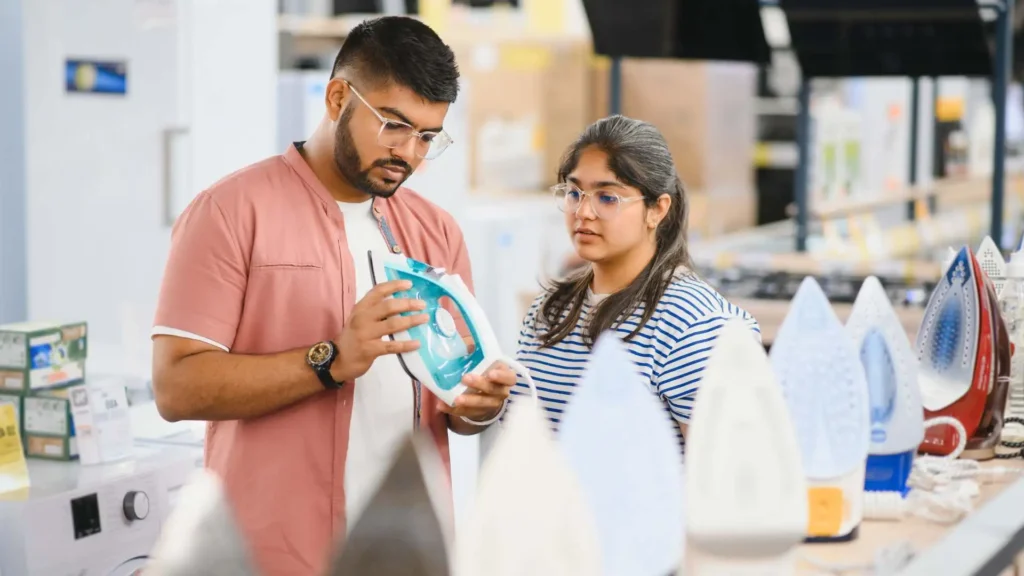College life in the USA is expensive. From laptops and headphones to smartphones and kitchen gadgets, students are constantly making purchase decisions that impact their budgets. One of the smartest ways to stretch your dollar is to consider refurbished products—but how do you know when to buy refurbished vs new, and how can you be sure you’re getting the best deal?
This guide breaks down the differences, pros and cons, and decision-making process, and shows how PriceGPT from Blitz Money can help you confidently choose and save. Let’s discover all about refurbished vs. new products.
Refurbished vs. New: What’s the Difference?
What Makes a Product “Refurbished”?
A refurbished product is an item that has been returned to the manufacturer or seller for various reasons—maybe it had a minor defect, cosmetic damage, or was simply an unwanted gift. The key is that it undergoes a rigorous inspection, repair, and testing process before being resold. Reliable refurbished products are restored to “like new” condition, often by certified technicians, and typically come with at least a limited warranty.
Example: Refurbished laptops are wiped clean, repaired, and tested for full functionality, sometimes with new batteries or screens installed.
Read: Can AI Really Find Better Prices? Putting PriceGPT to the Test
What to Expect from a New Product
A new product is just that—brand new, never used, straight from the manufacturer. It comes with the full manufacturer’s warranty, the latest features, and the peace of mind that you’re the first owner. For many, this is the gold standard, especially for high-use or mission-critical items.
Key Advantages and Drawbacks of Each Option
Cost and Value
Refurbished:
- Typically 30–70% cheaper than new, making high-performance tech accessible on a student budget.
- Lets you afford premium brands or specs you might not otherwise consider.
New:
- You pay a premium for the latest features, untouched hardware, and full warranty coverage.
- New items depreciate quickly, especially electronics.
Warranty and Support
Refurbished:
- Most reputable sellers offer a limited warranty (often 3–12 months).
- Support may be less comprehensive than with new products, but top refurbishers stand behind their work.
New:
- Standard manufacturer warranty (often 1 year or more) with the option to purchase extended coverage.
- Full access to customer support, updates, and sometimes free returns.
Check this out: How Image-Based Price Comparison Makes Finding Deals Easier for College Students?
Sustainability and Environmental Impact
Refurbished:
- Choosing refurbished reduces electronic waste and extends the life of tech products.
- Eco-conscious students can make a real difference by opting for upcycled devices.
New:
- New products require new resources, energy, and packaging—higher environmental footprint.
Risks and Considerations
Refurbished:
- Potential for minor cosmetic flaws (scratches, dings).
- Shorter lifespan if not properly refurbished—always buy from trusted sources.
- Return policies may be stricter.
New:
- Higher upfront cost.
- Less risk of hidden issues or prior wear.
Read: Find Black Friday’s Best Deals Faster with PriceGPT
When to Choose Refurbished or New
Deciding between refurbished and new products isn’t just about the price tag—it’s about fit, function, and future value. Here’s how to make the right call as a college student:
When Refurbished Makes Sense
Stretch Your Budget Further
If you’re working with limited funds but need reliable tech, refurbished is a smart choice. Refurbished laptops, tablets, and headphones often cost 30–70% less than their new counterparts, letting you access premium brands or higher specs that would otherwise be out of reach. For example, a refurbished MacBook Air or Dell XPS can offer the same performance as new, but at a price that won’t drain your savings.
Eco-Conscious Choice
Choosing refurbished isn’t just good for your wallet—it’s good for the planet. By opting for upcycled tech, you help reduce electronic waste and support a circular economy. If sustainability matters to you, this is a win-win.
Best for Non-Essential or Secondary Devices
If you need a backup device, a secondary monitor, or a kitchen gadget for your dorm, refurbished options are ideal. You get functionality at a fraction of the price, and minor cosmetic flaws are often irrelevant for these use cases.
Great for Stable, Mature Tech
Products like last year’s laptops, headphones, or kitchen appliances—where the latest model isn’t a must—are perfect candidates for refurbished. You’ll often find devices with legacy ports or features that new models have phased out, which can be useful for compatibility with campus equipment.
Also Read: I Compared Prices of 10 Products on PriceGPT and Google Lens: Here’s Who Won
When New Is the Better Option
Mission-Critical or High-Use Devices
If your laptop is your lifeline for coursework, design projects, or coding, the peace of mind from a full manufacturer warranty and the latest tech might be worth the premium. New products are less likely to have hidden defects, and you’ll get the longest possible lifespan.
Gifts and First-Time Purchases
When buying a gift or your very first device, new is often preferable for presentation, warranty, and support reasons.
Rapidly Evolving Technology
If you need the latest features—such as for gaming, video editing, or specialized academic software—new models will have the edge in performance and longevity.
When Warranty and Support Are Non-Negotiable
Some refurbished items come with limited or shorter warranties. If you want the security of extended coverage, new is the way to go.
Read: How to Use PriceGPT to Track Price Drop and Get Notified Instantly
Summary Table: Refurbished vs. New Decision Points
| Scenario | Refurbished | New |
| Tight budget | ✅ | |
| Eco-conscious | ✅ | |
| Backup/secondary device | ✅ | |
| Mission-critical device | ✅ | |
| Latest features needed | ✅ | |
| Extended warranty required | ✅ |
For more decision-making tips, check out BlitzMoney’s student shopping guides.
How PriceGPT Simplifies Your Decision
Side-by-Side Comparisons
With PriceGPT, you can instantly compare refurbished vs new products for the same model across dozens of trusted retailers. See price differences, warranty details, and seller ratings at a glance.
How it works:
- Search for a product (e.g., “MacBook Air M2”).
- View side-by-side listings for both refurbished and new options.
- Filter by warranty length, seller reputation, and price.
Quality and Seller Insights
PriceGPT pulls in user reviews, seller ratings, and details about the refurbishment process, so you know exactly what you’re getting.
- Only see listings from certified refurbishers and authorized resellers.
- Access real user feedback on product condition and customer service.
Price Alerts and Deal Notifications
Set up alerts for both new and refurbished products. PriceGPT notifies you when your target price is hit—whether it’s a flash sale on a new device or a markdown on a certified refurbished model.
Real User Reviews and Ratings
Before you buy, read aggregated reviews from other students and shoppers. Learn about common issues, satisfaction levels, and tips for getting the best value.
Smart Shopping Tips
Whether you’re eyeing a refurbished deal or a new release, these best practices will help you buy with confidence:
1. Check Seller Credentials
Always buy from reputable sources. Look for “certified refurbished” labels or manufacturer-backed programs. Avoid generic “used” listings on peer-to-peer marketplaces unless you’re confident in the seller’s reputation. Trusted platforms like Blitzmoney.co only surface listings from verified vendors, reducing your risk.
2. Understand Warranty and Return Policies
Before you buy, review the length and coverage of the warranty. New products typically come with a 1-year (or longer) warranty, while refurbished items may have shorter coverage—often 3–12 months. Also, check the return policy; some refurbished deals are final sale, while others offer a 14- or 30-day return window.
3. Use PriceGPT’s Tools
Leverage PriceGPT’s side-by-side comparisons, price history charts, and deal alerts. Set up notifications for both new and refurbished products so you can strike when the price is right. Scan barcodes or upload receipts to verify you’re getting a genuine deal, and use the chat feature to ask about warranty, seller reputation, or alternative options.
4. Read User Reviews and Ratings
Don’t just take the seller’s word for it—see what other students say. PriceGPT aggregates reviews and ratings, so you can spot patterns (like frequent issues or standout customer service) and avoid common pitfalls.
5. Match Specs to Your Needs
Know what you need for your major or hobbies. For example, engineering or design students may need more RAM or a dedicated GPU, while humanities majors can opt for lighter, less expensive models. Refurbished devices often allow you to get higher specs for less.
6. Don’t Forget About Depreciation
New tech loses value quickly, especially in the first year. Refurbished gadgets have already taken the biggest depreciation hit, so you’re less likely to lose money if you upgrade or resell later.
Check this out: Snap, Scan, Save: How Blitz’s PriceGPT Helps Students
7. Prioritize Sustainability
If reducing your environmental impact is important, refurbished is the clear winner. You’ll be supporting a more sustainable tech ecosystem and helping to keep electronics out of landfills.
For more practical shopping advice, browse BlitzMoney’s blog for the latest student money hacks and tech buying guides.

Why College Students Should Use PriceGPT
As a college student, your time and money are precious. Here’s why Blitz is your ultimate shopping companion:
1. Real-Time, Personalized Comparisons
PriceGPT isn’t just another price comparison tool. It uses AI to instantly show you the best deals for both new and refurbished products, factoring in your preferences, trending student searches, and even your purchase history. No more endless tab-switching or manual research.
2. Transparent, Trustworthy Information
With PriceGPT, you see everything you need to make an informed decision:
- Price differences between new and refurbished
- Warranty details and seller ratings
- Aggregated user reviews
- Price history charts to spot true deals (not fake discounts)
Read: Price Comparison with AI: The Student’s Guide to Using PriceGPT Effectively
3. Automated Alerts and Reminders
Never miss a deal again. Set alerts for specific products, and PriceGPT will notify you when prices drop—whether it’s a flash sale on a new laptop or a markdown on a certified refurb. You can also set reminders for upcoming bills or recurring expenses, helping you stay on top of your budget.
4. Smarter, Data-Driven Decisions
PriceGPT analyzes transaction patterns, spending habits, and even location data to recommend the best value for your needs. For example, if you’re spending more on off-campus purchases, PriceGPT can suggest on-campus alternatives or group buying opportunities.
5. Saves Time and Reduces Stress
The AI-powered chat and quick prompts mean you get answers fast—no more information overload. Whether you’re comparing yoga mats, headphones, or laptops, PriceGPT makes the process seamless and stress-free.
6. Supports Sustainable Choices
By surfacing high-quality refurbished options alongside new products, PriceGPT empowers you to make greener, more responsible choices—without sacrificing performance or peace of mind.
Check this out: What Types of Products Can Be Compared Using a PriceGPT?
7. All-in-One Platform for Student Life
From tracking price drops and managing subscriptions to finding group deals and scanning receipts, PriceGPT and Blitz are built specifically for student needs. You can even resume past chats and purchase history in the Archives tab, making it easy to track your savings journey.
Ready to shop smarter?
Start your next search on Blitz and explore more student savings tips at blog.blitzmoney.co. With PriceGPT, you’re not just saving money—you’re building lifelong smart shopping habits. Make every purchase count. Choose with confidence. Save with PriceGPT. Download the Blitz app here.





